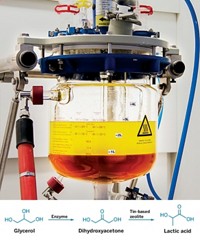Advertisement
Grab your lab coat. Let's get started
Welcome!
Welcome!
Create an account below to get 6 C&EN articles per month, receive newsletters and more - all free.
It seems this is your first time logging in online. Please enter the following information to continue.
As an ACS member you automatically get access to this site. All we need is few more details to create your reading experience.
Not you? Sign in with a different account.
Not you? Sign in with a different account.
ERROR 1
ERROR 1
ERROR 2
ERROR 2
ERROR 2
ERROR 2
ERROR 2
Password and Confirm password must match.
If you have an ACS member number, please enter it here so we can link this account to your membership. (optional)
ERROR 2
ACS values your privacy. By submitting your information, you are gaining access to C&EN and subscribing to our weekly newsletter. We use the information you provide to make your reading experience better, and we will never sell your data to third party members.
Environment
Glycerol-chomping cyanobacteria work night and day to produce polymer precursors
The engineered bacteria can use both carbon dioxide and glycerol to make 2,3-butanediol
by Ryan Cross
October 3, 2016
| A version of this story appeared in
Volume 94, Issue 39
Cyanobacteria are an attractive candidate for renewable production of microbe-derived chemicals, thanks to their plantlike power that converts sunlight and carbon dioxide to energy. But scaling up production is difficult, partially because of sunlight limitations in large industrial facilities. Shota Atsumi at the University of California, Davis, is seeking to bypass that problem by engineering the cyanobacteria species Synechococcus elongatus to metabolize a second carbon source, glycerol: a cheap and abundant by-product of biodiesel production. “Glycerol provides an energy source at nighttime; otherwise, we can only use half the day,” Atsumi says. He previously engineered the species to produce 2,3-butanediol, a common polymer precursor (Proc. Natl. Acad. Sci.USA 2013, DOI: 10.1073/pnas.1213024110). In the new study, Atsumi inserted genes for enzymes that enable glycerol digestion in cyanobacteria, allowing them to produce 2,3-butanediol both day and night, approximately quadrupling the previous output (ACS Synth. Biol. 2016, DOI: 10.1021/acssynbio.6b00239). “New uses for glycerol are always good for the development of a sustainable society, since glycerol is a major by-product of the biodiesel industry,” says Ethan I. Lan of National Chiao Tung University. “They made cyanobacterial biochemical production one step closer to industrialization,” Lan says.




Join the conversation
Contact the reporter
Submit a Letter to the Editor for publication
Engage with us on Twitter